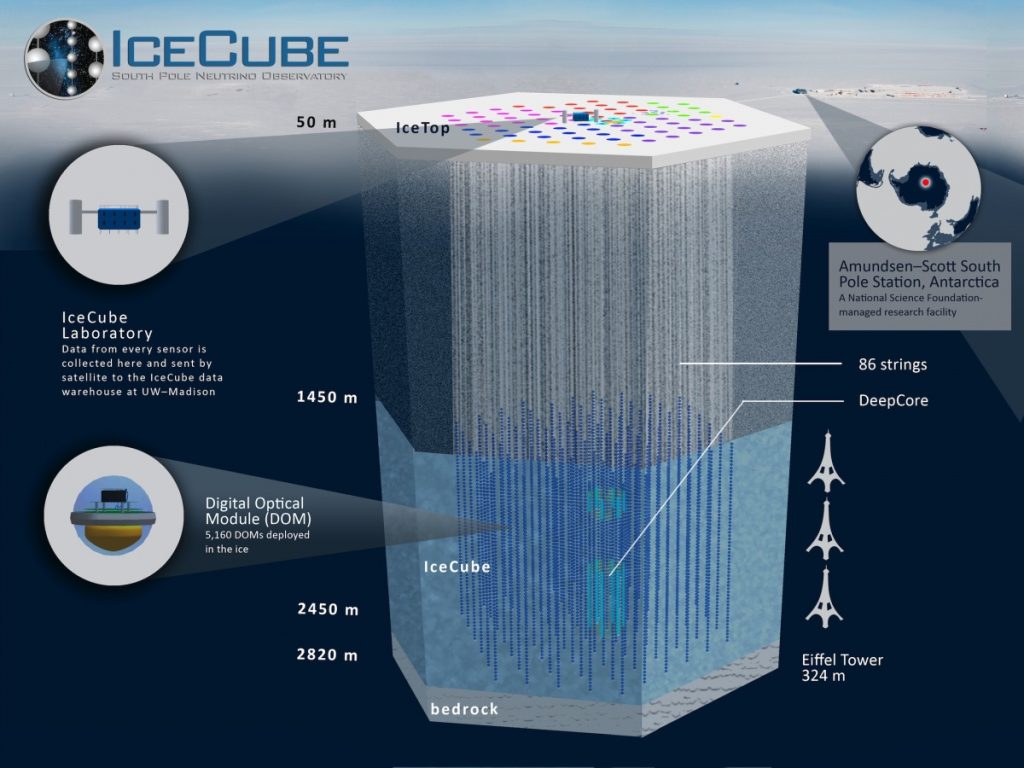IceCube is a unique experiment. It is an Earth-based telescope that uses the ice in Antarctica as the detector medium. The detector extends deep in the ice with a footprint of one square kilometer near the Amundsen-Scott South Pole Station.
Over five thousand sensors, called DOMs, in a cubic kilometer of ice are looking for signals of neutrinos coming from outer space, from the places where cosmic rays are accelerated to ultrahigh energies. Cosmic rays are composed primarily of high-energy protons and atomic nuclei, and their origin and nature has been a conundrum since their discovery in 1912.

However, neutrinos are not the only particles that reach IceCube. Everyday, millions of muons are detected, which have been created by the interaction of cosmic rays with the atmosphere. A muon is a particle similar to the electron, but with a mass about 200 times larger. Plenty of neutrinos are also created in those atmospheric cosmic ray interactions.
What does IceCube see?
- 250 million events are detected every day, but only a few hundred are neutrinos
- Most of the neutrinos observed were created in the atmosphere, and only a few dozen per year are neutrinos originating beyond our solar system.
Video: Why Neutrinos Matter, Ted-Ed Lesson
Article: IceCube Science, http://student.societyforscience.org/article/icecube-science
Video: IceCube Neutrino Observatory: Animated Overview
The video above was produced by Casey O’Hara, a PolarTREC teacher that worked with IceCube team in 2009-2010 season.
Why neutrinos?
Neutrinos are tiny particles that can travel through the Universe, crossing galaxies and even stars, without changing their direction or speed. They have very little mass and no charge, and they do not feel the strong nuclear force. But they do interact through the weak nuclear force.
Neutrinos are everywhere. They were created during early stages of the Big Bang and are generated in or near extreme cosmic objects such as black holes. They are produced by the nuclear reactions that power the Sun and by the interaction of cosmic rays in the Earth’s atmosphere.
Neutrinos fill the whole universe, with over 300 of them per every cubic centimeter. They are the second most abundant particle in the universe, with only photons being more common. Billions of solar neutrinos pass through every corner of the Earth every second, and trillions of them are created every minute by the interaction of cosmic rays in the Earth’s atmosphere.
Neutrinos are very difficult to detect, even though they are abundant and everywhere, because they are minuscule, neutral particles that only feel the weak nuclear force. That’s why scientists often call them ghost particles.
They have been studied for more than sixty years, but IceCube was built to start a new era in astronomy with neutrinos. Very high energy neutrinos coming from outside our solar system are ideal cosmic messengers. They are the only particles that will directly point to their origins, and their properties allow us to dig into the powerful physical processes that have created and fuel the extremes of our Universe.
IceCube was completed in December 2010, and has already observed the most energetic neutrinos ever detected. The first evidence of a flux of very high energy neutrinos coming from outer space was published in Science in November 2013. And new discoveries are just around the corner!
Article: Cosmic Gall, a poem about the neutrino, by John Updike
http://www.symmetrymagazine.org/article/february-2011/deconstruction-cosmic-gall
Article: Neutrino, explain it in 60 seconds
http://www.symmetrymagazine.org/article/april-2010/explain-it-in-60-seconds-neutrino
Video: Neutrinos: Nature’s Ghosts?


